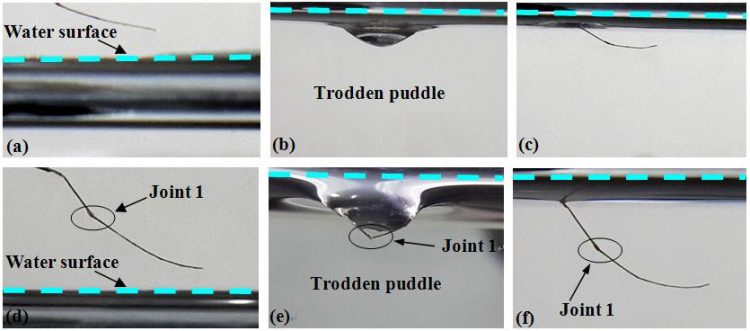Float Like a Mosquito, Sting Like a…Mosquito

Jianlin Liu/China University of Petroleum (a–c) Sequence of the terminal half of a tarsus progressively depressing the water surface. (d–f) Sequence of the whole hind leg progressively depressing the water surface.
Small semi-aqueous arthropods, such as mosquitoes and water striders, are free to go about their waterborne business thanks to their unique leg-based adaptations, which repel water and allow them to float freely on the surface.
By examining the forces that the segments of mosquito legs generate against a water surface, researchers at the China University of Petroleum (Huadong) and Liaoning University of Technology have unraveled the mechanical logic that allows the mosquitoes to walk on water, which may help in the design of biomimetic structures, such as aquatic robots and small boats.
“The current analyses deepen our understanding of the mechanisms of water-walking of these aquatic insects,” said Jianlin Liu, a professor in the Department of Engineering Mechanics at the China University of Petroleum. They describe their current research in the journal AIP Advances, from AIP Publishing.
Mosquitoes land on still bodies of water to lay their eggs just under the surface, where the embryos will hatch and develop into a pupa, eventually emerging from the water as a mature adult to continue the cycle.
A mosquito leg consists of three segments coated in grid-like, microscopic hydrophobic scales: a stiff femur juts out from the insect's abdomen and connects at a joint to an equally stiff tibia, which branches into a long, flexible tarsus. Previous measurements of the ability of water surfaces to support insects had largely ignored the tarsus, however, focusing instead on whole legs.
The researchers measured the buoyant force produced by the tarsus by adhering a mosquito leg to a steel needle, which was attached to an indenter column and microsensor. This in-situ setup allowed them to adjust the angle and force between the leg and the water's surface, while taking readings with an optical microscope and digital camera.
Liu and his colleagues found that the insect's ability to float on water – generating an upward force of twenty times its own body weight with its six legs – is owed entirely to the tarsus's buoyant horizontal contact with the surface.
“This finding overthrows the classical viewpoint that the longer the mosquito leg, the more efficiently it produces buoyant force,” Liu said.
By reducing the total surface area of the leg in contact with water, the adhesive force of the water on the insect is greatly reduced, which assists in takeoff.
The structural ability of the tarsus to achieve such a large supporting force per unit length, however, remains an ongoing research endeavor for the team. Future work for Liu and his colleagues involves studying the microstructures, wet adhesive forces and dynamic behavior of mosquito legs.
The article, “Load-bearing ability of the mosquito tarsus on water surfaces arising from its flexibility,” is authored by Xiang-qing Kong, Jianlin Liu, Wen-jiao Zhang and Qu Yandong. It will appear in the journal AIP Advances on March 3, 2015 (DOI: 10.1063/1.4908027). After that date, it can be accessed at: http://scitation.aip.org/content/aip/journal/adva/5/3/10.1063/1.4908027
ABOUT THE JOURNAL
AIP Advances is a fully open access, online-only, peer-reviewed journal. It covers all areas of applied physical sciences. With its advanced web 2.0 functionality, the journal puts relevant content and discussion tools in the hands of the community to shape the direction of the physical sciences. See http://aipadvances.aip.org
Contact Information
Jason Socrates Bardi
+1 240-535-4954
jbardi@aip.org
Media Contact
All latest news from the category: Physics and Astronomy
This area deals with the fundamental laws and building blocks of nature and how they interact, the properties and the behavior of matter, and research into space and time and their structures.
innovations-report provides in-depth reports and articles on subjects such as astrophysics, laser technologies, nuclear, quantum, particle and solid-state physics, nanotechnologies, planetary research and findings (Mars, Venus) and developments related to the Hubble Telescope.
Newest articles

NASA: Mystery of life’s handedness deepens
The mystery of why life uses molecules with specific orientations has deepened with a NASA-funded discovery that RNA — a key molecule thought to have potentially held the instructions for…

What are the effects of historic lithium mining on water quality?
Study reveals low levels of common contaminants but high levels of other elements in waters associated with an abandoned lithium mine. Lithium ore and mining waste from a historic lithium…

Quantum-inspired design boosts efficiency of heat-to-electricity conversion
Rice engineers take unconventional route to improving thermophotovoltaic systems. Researchers at Rice University have found a new way to improve a key element of thermophotovoltaic (TPV) systems, which convert heat…



